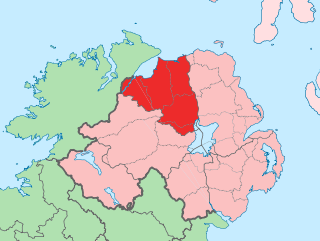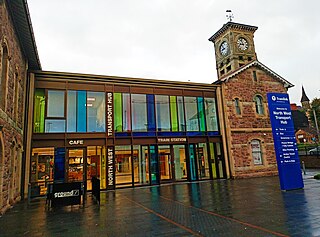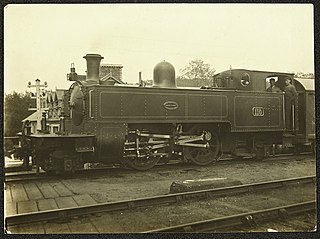
County Londonderry, also known as County Derry, is one of the six counties of Northern Ireland, one of the thirty-two counties of Ireland and one of the nine counties of Ulster. Before the partition of Ireland, it was one of the counties of the Kingdom of Ireland from 1613 onward and then of the United Kingdom after the Acts of Union 1800. Adjoining the north-west shore of Lough Neagh, the county covers an area of 2,118 km2 (818 sq mi) and today has a population of about 252,231.

NI Railways, also known as Northern Ireland Railways, is the railway operator in Northern Ireland. NIR is a subsidiary of Translink, whose parent company is the Northern Ireland Transport Holding Company (NITHCo), and is one of nine publicly owned train operators in the United Kingdom, the others being Direct Rail Services, Caledonian Sleeper, Northern Trains, Transport for Wales Rail, Southeastern, LNER, ScotRail, and TransPennine Express. It has a common Board of Management with the other two companies in the group, Ulsterbus and Metro.

The Ulster Transport Authority (UTA) ran rail and bus transport in Northern Ireland that operated from 1948 until 1967.

The Northern Counties Committee (NCC) was a railway that served the north-east of Ireland. It was built to Irish gauge but later acquired a number of 914 mm narrow gauge lines. It had its origins in the Belfast and Ballymena Railway which opened to traffic on 11 April 1848.

Lough Foyle, sometimes Loch Foyle, is the estuary of the River Foyle, on the north coast of Ireland. It lies between County Londonderry in Northern Ireland and County Donegal in the Republic of Ireland. Sovereignty over the waters has been in dispute since the Partition of Ireland.

Derry ~ Londonderry railway station, also known as North West Transport Hub or Waterside railway station, is a railway terminus in Derry, Northern Ireland, on the east bank of the River Foyle, operated by Northern Ireland Railways and its 7th busiest station across the network with 952,126 passengers boarding or alighting at the station in the 2023/24 financial year. It is on the Belfast–Derry railway line, terminating at Belfast Grand Central. Derry/Londonderry has the longest platforms on the NIR Network, at 258.3 metres in length.

The NCC Class WT is a class of 2-6-4T steam locomotives built by the Northern Counties Committee's parent company, the London, Midland and Scottish Railway for service in Northern Ireland.

The Ulster Transport Authority Multi-Purpose Diesel was a diesel powered railcar, used in Northern Ireland. It was developed by the Ulster Transport Authority (UTA) as a progression of the earlier Multi-engined Diesel (MED). The MED concept, while suitable for short commuter links, was not considered so for the Northern Counties Committee section, with its main line from Belfast to Derry where speeds of up to 110 km/h (68 mph) were required. A new railcar development was needed, and the MED was superseded by the MPD.
The Belfast and Northern Counties Railway (BNCR) Class A was a class of 13 two-cylinder compound steam locomotives built for service in north-east Ireland. The first two members of the class would be the last locomotives to be built for the independent BNCR, being completed before its purchase by the Midland Railway in 1903. The members of the class were rebuilt by the LMS (NCC) becoming either Class A1 or Class U2 depending on how they had been modified.

The Northern Counties Committee (NCC) Class U2 4-4-0 passenger steam locomotives consisted of 18 locomotives built for service in Northern Ireland. Ten of the engines were new builds supplied by the North British Locomotive Company (NBL) or constructed at the NCC's York Road works. The remainder were rebuilds of existing locomotives.

The Belfast–Derry line is an intercity railway line, running from Belfast to Derry in Northern Ireland. It is the westernmost railway line in the United Kingdom. Like all other railway lines in Northern Ireland, it is not electrified and all trains are diesel-powered.

The Belfast and Northern Counties Railway (BNCR) Class S was a class of 2-4-2T two-cylinder compound steam locomotives that was introduced for service on the 3 ft narrow gauge railways of County Antrim in north-east Ireland.

Benone is a popular tourist destination in the Causeway Coast and Glens district, County Londonderry, Northern Ireland.
Bowman Malcolm was an Irish railway engineer. He became Locomotive Superintendent of the Belfast and Northern Counties Railway (BNCR) at the age of 22 and later took on the additional role of Civil Engineer. He was an advocate of compound locomotives which he introduced to the BNCR.
The Northern Counties Committee (NCC) Class S1 was a class of two-cylinder compound 2-4-2T steam locomotives that was introduced for service on the 3 ft (910 mm) narrow gauge railways of County Antrim in north-east Ireland. The members of the class were rebuilds of the BNCR Class S.
The LMS (Northern Counties Committee)Class A1 4-4-0 passenger steam locomotives were rebuilds of Belfast and Northern Counties Railway Class A two-cylinder compound locomotives. They operated services throughout the NCC’s 5 ft 3 in (1,600 mm) broad gauge system in the north-east of Ireland.
The Belfast and Northern Counties Railway Class B was a class of 4-4-0 two-cylinder compound steam locomotives that was introduced for passenger service in the north-east of Ireland during the late 1890s.
Ballycastle Railway was a 3 ft narrow gauge railway line which ran from Ballycastle to Ballymoney, both in County Antrim, Northern Ireland.

Causeway Coast and Glens is a local government district covering most of the northern part of Northern Ireland. It was created on 1 April 2015 by merging the Borough of Ballymoney, the Borough of Coleraine, the Borough of Limavady and the District of Moyle. The local authority is Causeway Coast and Glens Borough Council.
The Northern Counties Committee (NCC) Class W was a class of locomotives introduced in 1933 and allocated to express passenger duties from York Road, Belfast.






















